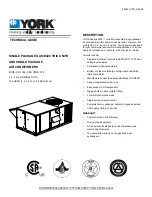
SAFETY PRECAUTIONS ...................................................................1
IDENTIFICATION OF PARTS ...........................................................3
INSTALLATION INSTRUCTIONS .....................................................5
CARE AND MAINTENANCE ............................................................10
AIR CONDITIONER FEATURES .......................................................11
OPERATING INSTRUCTIONS ..........................................................12
TROUBLESHOOTING .......................................................................14
CONTENTS
This manual provides the information needed for proper use and maintenance of
this air conditioner. Basic preventative care can help extend the life of this unit. The
“Troubleshooting” section in this manual contains a chart with solutions to the most
common problems. Referring to this section may save time and prevent the need for a
service call in the event of a problem.
NOTE:
The Energy Rating for this unit is based on an installation using an unextended exhaust duct
without adapters A or B (as shown in the Installation Section of this manual).
ENERGY SAVING TIPS
• Use the unit in the recommended room size.
• Locate the unit where furniture cannot obstruct the air flow.
• Keep blinds/curtains closed during the sunniest part of the day (cooling mode).
• Keep the filters clean.
• Keep doors and windows closed to keep cool air in and warm air out (cooling mode) or keep warm air in and cool air
out (heating mode for units with heat function).
NOTE:
All the illustrations in this manual are for explanation purposes only. Unit purchased may be slightly different.
The design and specifications are subject to change without prior notice for product improvement. Contact Consumer
Services at 844-4PA-AIRE (844-472-2473) for details.
OPERATING CONDITIONS
The air conditioner must be operated within the temperature range indicated below:
MODE
ROOM TEMPERATURE
COOL
62°F (17°C) – 86°F (35°C)
DRY
55°F (13°C) – 86°F (35°C)
NOTE:
Performance may be
reduced outside of these
operating temperatures.




































